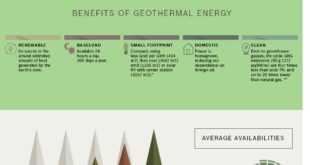Benefits of geothermal energy touted in air emissions analysis

The Geothermal Energy Association (GEA) has released an Air Emissions Comparison and Externality Analysis showing geothermal energy provides significant benefits to public health and the environment as one of the least-polluting and most environmentally friendly forms of energy. The analysis found binary geothermal plants produce virtually no greenhouse gases (GHG) and dry steam and flash geothermal plants put out only trace amounts of emissions. It estimates the public benefits from clean energy produced in California and Nevada are worth more than $117 million annually.
“Energy production and use is a major source of environmental and public health damage, and geothermal energy is a truly remarkable resource because it harnesses the power of the Earth to produce large amounts of power with virtually no impact,” said GEA Executive Director Karl Gawell. “Geothermal has tremendous untapped potential to provide energy without adding harmful elements into the environment.”
According to the report, geothermal energy emerges as one of the least polluting and environmentally unobtrusive forms of energy, having the lowest lifecycle emissions of any generating technology. Dry steam and flash geothermal energy plants emit about 5% of the carbon dioxide, 1% of the sulfur dioxide, and less than 1% of the nitrous oxide emitted by a coal-fired plant of equal size; and binary geothermal plants produce near-zero emissions. This is advantageous to public health, since many of the pollutants released in energy production carry negatives health consequences.
Additional benefits of geothermal energy include less land degradation, air emissions and environmental harm; greater fuel diversity; and improved national security through the use of an indigenous energy source. Geothermal energy also adds to the economy by paying substantial property taxes and providing significant long-term local employment.
This analysis updates a 2005 paper published in the Electricity Journal and expands upon the methodology by incorporating more atmospheric pollutants into the calculation. The new information showed GEA researchers the benefit of producing power using geothermal sources—as opposed to fossil fuels—is worth 3.5 cents for coal, and 1 cent for natural gas per kWh. Additionally, GEA estimates geothermal provides approximately $88 million in externality benefits per year to California and $29 million to Nevadans by avoiding fossil fuel emissions.
“Geothermal energy carries a smaller environmental footprint than other energy sources, such as coal or natural gas,” said Benjamin Matek, GEA’s geothermal industry analyst and author of the updated report. “The absence of a fuel cycle reduces the impacts on transportation infrastructure, and geothermal power plants can use recycled waste water to reduce environmental impacts on water resources and treatment costs.”
The complete report is available at http://tinyurl.com/GEAExternalities.
 Alternative Energy HQ solar power for homes, wind energy, and bio fuel issues
Alternative Energy HQ solar power for homes, wind energy, and bio fuel issues









